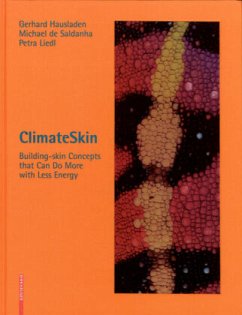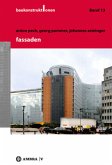The facade plays a critical role in the conception of energy- and climate-optimized buildings: it is the building’s skin and functions as an interface between interior and exterior space. It provides thermal and sound insulation and ventilation, and controls and guides the entrance of daylight into the building. Climate Skin offers concrete planning advice for architects and engineers who wish to exploit not only the architectural potential of facades but also their energy and climate-control possibilities, treating the building envelope as an essential component within a complete climate-control and technology solution. It provides a solid foundation of knowledge that equips the reader to make competent technical and economic evaluations of building envelopes. For everyone concerned with facades, Climate Skin is a comprehensive planning handbook and reference work that covers all of the relevant technical and physical aspects of the design and detailed planning of energy-efficient facades.
Bei der Konzeption von energetisch und raumklimatisch optimierten Gebäuden spielt die Fassade eine Schlüsselrolle: Sie ist die Haut des Gebäudes und fungiert als Schnittstelle zwischen Innen- und Außenraum. Sie erfüllt thermische Ansprüche und Lüftungsfunktionen und dient der Tageslichtlenkung sowie dem Schallschutz.
Climate Skin wendet sich mit konkreten Planungshinweisen an Architekten und Ingenieure, die neben den architektonischen auch die energetischen und raumklimatischen Potenziale der Fassade ausschöpfen und die Gebäudehülle als wesentlichen Baustein eines ganzheitlichen Klima- und Technikkonzepts nutzen möchten. Es vermittelt eine Wissensgrundlage, um Gebäudehüllen kompetent beurteilen und damit technische und ökonomische Konsequenzen abschätzen zu können. Für alle, die sich mit dem Thema Fassade beschäftigen, ist Climate Skin ein umfassendes Planungshandbuch und Nachschlagewerk für sämtliche relevanten technischen und physikalischen Aspekte rund um Entwurf und Detailplanung energieeffizienter Fassaden.
Hinweis: Dieser Artikel kann nur an eine deutsche Lieferadresse ausgeliefert werden.
Bei der Konzeption von energetisch und raumklimatisch optimierten Gebäuden spielt die Fassade eine Schlüsselrolle: Sie ist die Haut des Gebäudes und fungiert als Schnittstelle zwischen Innen- und Außenraum. Sie erfüllt thermische Ansprüche und Lüftungsfunktionen und dient der Tageslichtlenkung sowie dem Schallschutz.
Climate Skin wendet sich mit konkreten Planungshinweisen an Architekten und Ingenieure, die neben den architektonischen auch die energetischen und raumklimatischen Potenziale der Fassade ausschöpfen und die Gebäudehülle als wesentlichen Baustein eines ganzheitlichen Klima- und Technikkonzepts nutzen möchten. Es vermittelt eine Wissensgrundlage, um Gebäudehüllen kompetent beurteilen und damit technische und ökonomische Konsequenzen abschätzen zu können. Für alle, die sich mit dem Thema Fassade beschäftigen, ist Climate Skin ein umfassendes Planungshandbuch und Nachschlagewerk für sämtliche relevanten technischen und physikalischen Aspekte rund um Entwurf und Detailplanung energieeffizienter Fassaden.
Hinweis: Dieser Artikel kann nur an eine deutsche Lieferadresse ausgeliefert werden.








